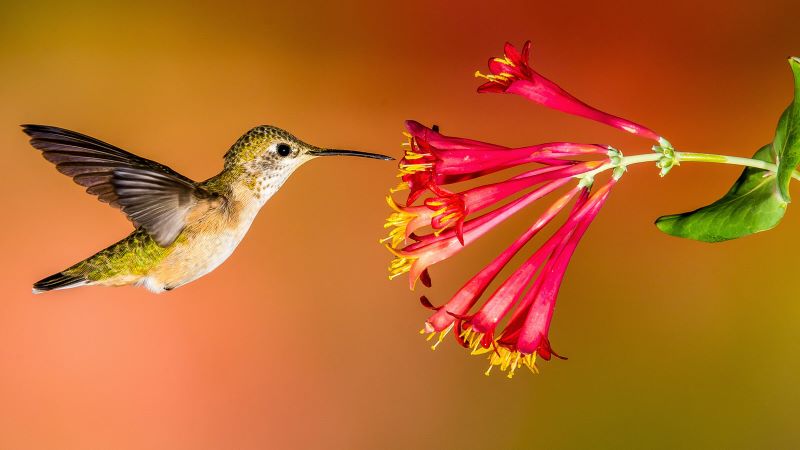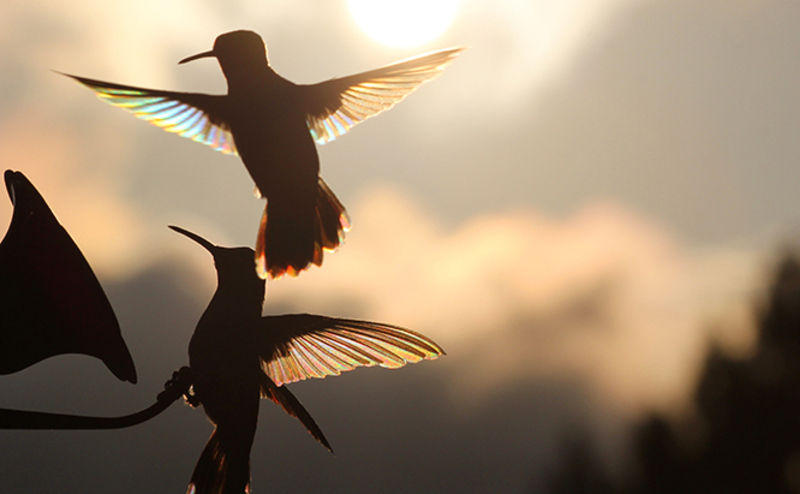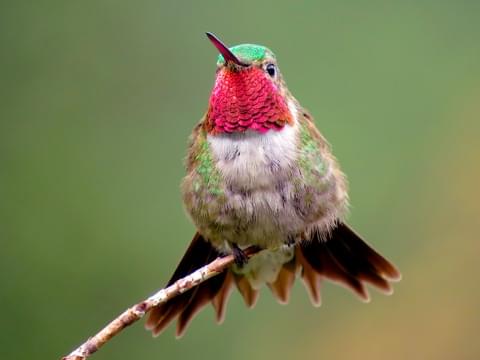The sweet, fast hummingbirds that you love to watch at your feeder aren’t always as nice as they seem. When they chase each other, they aren’t always doing it to have a good time. Hummingbirds are actually quite territorial. These backyard birds are exciting to watch, but keep an eye out to see their scary side.

Fighting
These tiny birds have a big attitude. They don’t like when another bird steps on their breeding territory or in the way of their precious nectar. The rufous hummingbird probably has the worst temper of all of the others in North America. If you’re watching out for a fight, you might see it in late spring or early summer. This is when the birds are best at defending their nests and claiming their territory.
The really angry birds will still be showing aggression well into fall. This is when they’re getting ready to migrate, so it’s time to defend their prime feeding territories. The male hummingbird will fight anything that stands in the way of its feeder. The female hummingbird is more apt to guard her nest.

Playful Chasing
So, why do hummingbirds chase each other when they aren’t ready to fight? You’ll notice sometimes hummingbirds aren’t fighting, but simply chasing the other one. This is more of a playful dance. This little dance is all about courtship and mating. A hummingbird has an interesting mating ritual. It will play and chase another hummingbird in an attempt to flirt. It does almost look as if they’re fighting during this ritual.
The male hummingbirds engage will do a version of a dance to get attention. They’re also sending signals to the females that they’re ready to mate. They puff out their bodies so they look big and bad. They like to show off their colorful feathers so a female hummingbird will notice how cute they look. If he spots a female on a perch, the male hummingbird will show off by flying outstretched with his tail feathers in the wind. He’s showing off his muscles to her.
If you get to see this chase in person, you’re in for a delightful show. It’s funny and educational at the same time. They will dip and dive to get more attention. You should notice the difference between courting and fighting because courtship is all about being playful and showing off instead of showing any signs of aggression.

Signs of Aggression
Hummingbirds show aggression because they don’t want you on their turf. Males are extremely aggressive when they’re trying to establish a new territory because they’re trying to keep the female and the young hummingbirds safe. This male is claiming his land and breeding with multiple female hummingbirds. He doesn’t like people trying to take away his nice little life. There are many ways you may see hummingbirds showing their aggression.
Strange Sounds
Just like if someone was trying to get into your home, a hummingbird may shout and buzz at an intruder. These sounds range from being loud and fast-paced to chattering and buzzing. They do everything they can to let an intruder know that they’re in their world. Many times the hummingbird will simply raise its volume or start singing at a faster speed. This means it’s time to get off their territory or get ready for a fight.
The Chase
Remember we asked, Why do hummingbirds chase each other? Sometimes they don’t do it for fun. In this instance, they are chasing the other bird out of their territory. They’re showing aggression by charging at the other bird. They want to follow them as far away from their feeder or their food as possible. You may hear those scary sounds as they chase the other bird away. Many times, the dominant hummingbird will confront the other bird on their territory before charging at them.
Threat Posture
A hummingbird may be tiny, but it has a big threat posture. It will show off its strength to send the signal to violators. The male hummingbird will flare his feathers to show off his colors. Many other birds will flare their tails, raise their feathers, or spread their wings. They will sometimes even point their bills at the intruder.
Deep Dive
If you see a hummingbird dive, you better move out of its way. It will often hover in front of its enemy then dive straight down at them. They usually make loud sounds as they dive. This is all done as a warning to the burglar.
Fighting
Hummingbirds will finally resort to fighting when the intruder won’t get away from their territory. They will use their sharp claws and beaks to attack another bird. They’ve been known to grab another hummingbird by its tail with their peak, pulling them away from their feeder. Sometimes they will ram into them while flying. This can go on for many hours. The bad news is that these fights can sometimes be deadly.

Spoiling Your Fun
If this fighting stresses you out while watching your hummingbirds, you can do a few things to help alleviate these actions. Remember, it’s natural for hummingbirds to scuffle over territory and food. Watch out for a bully bird. There may be one mean hummingbird trying to take over your yard. Once you learn why they’re fighting, it will be easier to fix the issues in your own yard.
Feeder Spacing
Space hummingbird feeders as far apart as possible so you can curb aggressive behaviors. There will also be hummingbirds in the mix that aren’t very aggressive. This will give them a chance to get some food from the feeders before the “mean” ones come in to chase them away. One viable solution is a feeder like the Frolic Feeder (pictured above), which gives hummingbirds separate feeding receptacles. This could be enough to get them off of each others’ backs.
Additional Feeders
Add feeders to your yard to reduce fighting by the birds. One bully bird won’t be able to defend a large number of feeders. This will also give access to many different hummingbirds. They can space out and enjoy their dinner on their own feeder.
Placement Of Feeders
You can create many different locations for your feeders. Place them in different areas so hummingbirds have the opportunity to feed in different places. They won’t fight as much. They may even be out of sight of the other hummingbirds. If they cannot see each other, they can’t fight over every location of the feeder.
Perch Positions
A bully bird may hang out on its little perch. Watch where this bully bird flies so you know where it likes to perch. You can remove this perch so they do not have such an aggressive vantage point.
Remove Issues
Watch the hummingbirds closely to see what is driving them mad. Once you discover why the birds are fighting so much, you can do something to fix the issues. Sometimes the issue may not even be another bird. There may be a true predator like a feral cat or even just a songbird. Once you eliminate this stress, the hummingbird will enjoy life much more. You can enjoy watching them more, too.
Hummingbirds are amazing to watch at your feeder. They go to great lengths to defend their territory. You have to respect the way they protect their environment. If you follow the guidelines to space their feeders and ensure every bird is happy, you should be in for a peaceful time of watching these sweet birds. Hopefully this article helped you to understand why these hummingbirds chase each other, and you can find a solution that works in your backyard. The joy of their play and their mating dance is priceless.
Related
- Want to learn more about hummingbirds? Check out 10 Hummingbird Facts And Myths
- Itching to attract more birds (like hummingbirds) to your yard? Find out how to turn your backyard into a bird sanctuary!
Leave a Reply